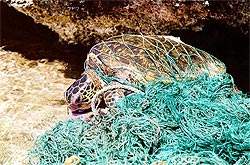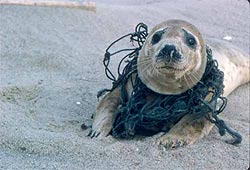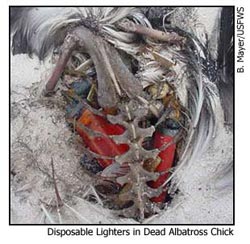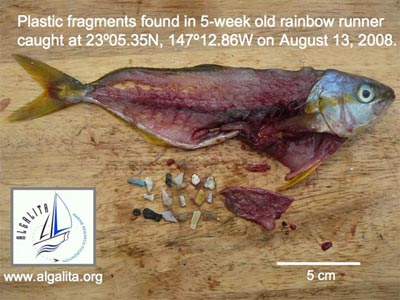Background Information
What is the Environmental impact of marine debris?
Marine debris is a danger to all sea creatures, and an added danger to the survival of species already listed as threatened or endangered. It causes problems to wildlife through:
Entanglement
Entanglement in marine debris can cause restrict movement of animals, starvation, infection, amputation, drowning and smothering.
Globally more than 250 species are known to be affected by marine debris. Turtles (86% of all sea turtle species), whales and other marine mammals. sharks, rays, crabs, seasnakes and seabirds (44% of all seabird species) may be severely injured and even die after entanglement with fishing lines, fragments of trawl netting (Ghost netting), crab or lobster pot gear and plastic packing straps.

Seabirds caught up in marine debris may lose their ability to move quickly through the water, reducing their ability to catch prey and avoid predators; or they may suffer constricted circulation, leading to suffocation and death. Fishing line debris, nets and ropes cut into the skin of whales or turtles, leading to infection or the slow and painful amputation of flippers, tails or flukes.
Up to 40,000 fur seals are killed each year when they get tangled in debris. This contributes to a population decline of 4-6% per year.

Ingestion
Marine species confuse plastic bags, rubber, balloons and sweets wrappers with prey and swallow them. The debris usually causes a physical blockage in the digestive system, leading to painful internal injuries. Turtles frequently eat plastic bags, confusing them with jellyfish, their common prey.
Sea birds eat polystyrene balls and plastic buoys, confusing them with fish eggs and crustaceans, and the Humpback, Southern Right and Blue Whales eat plastic debris. Grey Nurse Sharks swallow hooks that puncture their stomachs and oesophaguses causing infection and death.

The following endangered and vulnerable species are kown to be threatened by marine debris:
Endangered species
• Loggerhead Turtle
• Southern Right Whale
• Blue Whale
• Tristan Albatross
|
|
Vulnerable species
• Leatherback Turtle
• Hawksbill Turtle
• Flatback Turtle
• Green Turtle
• Wandering Albatross
• Humpback Whale
• Antipodean Albatross
• Gibson's Albatross
• Southern Royal Albatross
• Indian Yellow-nosed Albatross
• Grey Nurse Shark
• Grey-headed Albatross
• Blue Petrel
• Northern Giant Petrel
Very small plastic particles often resemble zooplankton and can be eaten by larger consumers so entering the food chain. Plastics, through their breakdown, can introduce toxic products into the food chain, some of these toxins (including DDT and PCBs) can build up as they move trhough the food chain (biomagnification).
Plastic is a particular danger to 20 Australian threatened species, listed under the
Environment Protection and Biodiversity Conservation Act.

As well as environmental impacts, marine debris can impact on human health, tourism, fisheries and shipping and have economic effects. For example, beaches in New York and New Jersey were closed for the summers of 1987 and 1988 due to the presence of large amounts of medical wastes including needles and bandages from hospitals. These wastes had washed ashore. Money was lost from tourism and cleanup costs can be very large!
Next: What can be done about marine debris? ...
|

